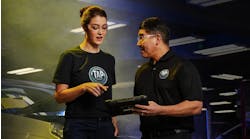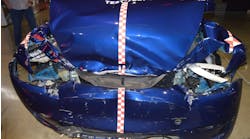When our 12-volt brain thinks about the 12-volt battery’s “State of Charge” (SOC), we know that 100% is the goal. The 12-volt battery wants to stay at 100% SOC all the time. In a hybrid vehicle, the small battery starts the car and the Nickel Metal Hydride (NiMH) or Lithium (li-ion) high voltage battery cranks the ICE (internal combustion engine), with some exceptions made by GM and Honda.
One more critical function is asked of the big battery and that is to store electrical energy when the vehicle is slowing down. That kinetic energy is converted to heat energy in a conventional car, truck or motorcycle when slowing down by the friction brakes. In a hybrid electric vehicle (HEV) the HV battery’s SOC is kept below 60% most of the time, so there is enough room to store some of the kinetic energy as electrical energy recovered by the “regenerative braking” system. Most new electric vehicles (EVs) have a setting on the dash so the driver can set the upper limit of the SOC when plugged in. The recommendation for EVs is 80% SOC.
These NiMH modules were the start of EV packs.
NiMH Battery Chemistry
NiMH batteries were very common when hybrids came out more than two decades ago. NiMH batteries were used in hybrid vehicles from 1997 to the mid-2010s, with the exception of Toyota Motor Corp. The cells have electrodes made of a metal hydride and nickel hydroxide. The electrolyte is potassium hydroxide. In 2013 the only major OEM to still use NiMH cells was Toyota. Most every other manufacturer had moved to a Lithium-type cell by then. More on that later.
Nickel-Metal Hydride (NiMH)
NiMH cells are available in a cylindrical and prismatic design. NiMH was the battery of choice for hybrids because of its cost and safety. That has changed. There are literally billions of NiMH cells in use around the world, so they will be around for a long time.
These cells were studied and developed for decades and it is not uncommon to see a Ford Escape Hybrid with 300,000 miles that still has the original battery pack. Some other pack designs have been a problem over the years, but overall, the outcome has been good. Problems did appear if any single cell was not built exactly like the next, or if the cells got extremely cold and were asked to work hard, or if they overheated or discharged too deeply. The HV battery ECU was programmed to not let that happen. Very hot climates also are not healthy for battery packs if the cooling systems are not liquid-based or have a separate A/C system.
In some instances, NiMH battery failure has not been caused by the battery cells, but rather by corrosion on the connectors. There have been some failures related to non-use. If a battery pack has not been cycled for a month or two, some cells lose their SOC more than others. Some manufacturers have placed a warning label stating that if the NiMH-equipped vehicle will not be used for more than a month, the battery may be damaged.
Examples of modern li-ion cells.
Lithium-Based Batteries
Lithium-based batteries are the norm today. They have higher energy density than NiMH and cost about the same to manufacture. There are two major types of lithium-based cells: lithium-ion and lithium-polymer.
Lithium-Polymer (Li-Poly)
The lithium-polymer battery is a close relative to a lithium-ion battery. The big difference is the “electrolyte.” It is held in a thin, semi-solid, polymer rather than as a liquid. The solid polymer electrolyte is not as flammable; therefore, these batteries are less hazardous if they are mistreated. These batteries can be shaped to fit the application and are currently being used in some electrified motor vehicles (EMVs) such as Kia and Hyundai.
Closeup of a balancing circuit.
Lithium-ion (li-ion)
All vehicles that plug into the grid use lithium cells, but automotive cells do not use pure lithium metal due to safety issues; instead, they use lithium compounds. The term lithium-ion (li-ion) applies to cells that use lithium regardless of the other metals mixed with the lithium. These compounds are the focus of much research. Li-ion cells have a voltage output of 3.2 to 4.0 volts. The compounds used in the cell determine the energy density of the cell and the output voltage. Safety issues also surface when connecting li-ion cells, in series or in parallel, to form a battery pack. Not all lithium-ion cells are designed to be used in an EMV.
Lithium-ion cells were expensive to produce, but with the sales of plug-in cars the prices have dropped to levels near NiMH. In a li-ion pack design, each cell must be monitored and requires protection circuits and balancing circuits. Because lithium metal is very reactive and can explode, the cycling of the battery must be monitored. A protection circuit limits the peak voltage of each cell during charging and prevents the voltage from dropping too low during discharge. The temperature of the battery pack is also monitored. Charge and discharge activity is controlled to prevent high temperatures. The circuit also contains electronics and/or fuses to prevent polarity reversal. Cells connected in parallel will “self-balance,” so no balancing circuit is required. At ACDC we call cells in parallel a “group.”
Example of a Honda regen...when you let your foot off of the accelerator pedal, the HV pack will recharge.
Cell Balancing
When any lithium-based cell is used in a HV pack, be it a hybrid with the cells in series, or a plug-in vehicle where some cells are in parallel, an inexpensive circuit is hard wired from each cell or group. That balancing circuit monitors each cell (or group) for voltage. Those cells that are in parallel are called a group and should be considered as “one” cell for this discussion. Each cell is compared to every other cell in the pack. If one cell has a higher voltage reading than the others a small resistor is switched by the HV battery controller (ECU) to connect between the positive and negative connections of that one cell. The resistor will heat up so that cell (the one with the higher voltage) stops charging. This can happen to many cells at once as each cell has its own circuit. One by one, as the cells all reach the same voltage, the resistors are turned off and at the end of the recharging period all cells are at the same SOC. Every lithium battery pack used in a motor vehicle has this system in place. It keeps the entire pack performing well, limits fire issues, and allows the pack to last a long time. Once one cell can no longer stay at this optimum balance, the EMV will set a code and indicate which cell is defective. NiMH batteries were so safe they never had to incorporate cell balancing. Studying cell voltage PIDs in a good li-ion pack is boring, but do it anyway to learn more.
The Chevy Volt has three cells in parallel, called a “group.”
One Decade With Lithium Packs
Tesla released its Roadster in M/Y 2008 with a long-range liquid cooled li-ion high voltage battery pack. There were about 2,500 sold worldwide. Next with a li-ion pack was the Mitsubishi i-MiEV in M/Y 2009 and the Nissan Leaf in M/Y 2011. That was followed weeks later by GM when the Chevy Volt went on sale in December of 2010 as an M/Y 2011. They all had something in common: a li-ion battery pack to move the vehicle at high speed with just an electric motor.
Warning label on Honda. NiMH battery packs do not do well when not used.
What do we know now about the cars that have been using li-ion cells for over 10 years? Liquid cooling is a must. The Nissan Leaf has had serious capacity loss issues due to the lack of any cooling system. The other cars, Tesla for example, have had a good reputation for their li-ion pack. Leaving a plug-in vehicle connected to a Level I or II EVSE when not in use is a good idea. Most plug-in vehicles have a cooling and heating system and will try to keep the HV battery cells at 70 Fahrenheit (21 Celsius). The first decade of li-ion was better than the first decade with NiMH. More progress is inevitable.



